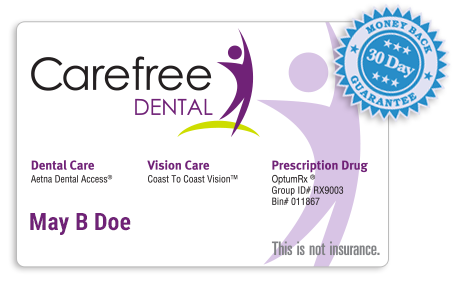How Much Do Braces Cost Without Carefree Dental?
The cost for braces can vary a lot depending on different factors, including what kind of braces you’re getting, the condition of your teeth, your provider’s individual pricing structure, and the length of time you need braces. But here are some general price guidelines, according to Angie’s List
For metal braces, the average cost is about $3,400 with insurance and $4,900 without insurance.
For ceramic braces, the average cost is about $2,600 with insurance and $4,600 without insurance.
For Invisalign, the average cost is about $2,100 with insurance and $5,600 without insurance.
For lingual braces, the average cost varies considerably from $5,000 to $13,000.
Read on for a description of the differences between these different types, along with a few strategies to get a better deal on your braces.
Other Potential Fees and Procedures
If the high cost of braces wasn’t enough, many people have to pay for additional dental work before they can even get started with braces. Some of these potential fees may include:
- Extractions. If your mouth is overcrowded, you may need to have a few teeth removed before having your braces installed. This can cost anywhere from $100-$350 per tooth.
- Deep cleaning. If your dentist finds evidence of gum disease, it may be wise to get a deep cleaning before getting started with braces to ensure that your gums are healthy.
- Fillings or filling replacements. If you have any new cavities, or any old fillings that need replaced, you should probably have this taken care of first. Keep in mind it would be more difficult for your dentist to perform a procedure like this after your braces are installed, so it’s a good idea to do this before getting your braces put on.
The Longer You Need Braces, The More You Pay
One reason why the cost for braces can vary so much is because there’s no set amount of time for how long you’ll need to wear them. Some people wear braces for only 6 months before their teeth are fixed, while some have to wear them for 3 years or even longer. It all depends on the state of your teeth and how quickly they adjust to the treatment.
And as you might expect, the length of treatment plays a big role in the total cost you have to pay for your braces. Typically you will have to visit your provider once a month to have your braces adjusted. So the longer you need braces, the more office visits you’ll make--and the more you’ll have to pay.
What’s the Best Discount Dental Plan for Braces?
Because they’re so expensive, most people use some sort of payment plans for braces to finance the procedure. We make it easy to get braces without insurance. The total cost for braces is often around $5,000, but can go above $10,000 for certain kinds of braces--and not many people have that kind of extra money lying around.
The most obvious way to save money on your braces is through dental insurance. Many people get dental insurance through their employer, which makes it a very common way to save money on braces.
However, there are a few problems with using insurance to help pay for braces:
- Some forms of dental insurance don’t cover braces. Make sure that your insurance covers the type of braces you want to get before you set your appointment.
- Insurance is time-consuming and complicated. You have to fill out paperwork, file claims, and spend a lot of time waiting for your claim to be processed.
- High monthly premiums. The policies with the most savings will also have the highest monthly payments, which can often exceed $50 per month in addition to your out-of-pocket costs for braces
- Many dental insurance policies have an annual savings cap. With many dental insurance policies maxing out around $1,000-$1,500, they may not provide enough savings to cover the full cost of your braces.
If any of these is an issue for you, then you might be interested in how Carefree Dental works to help lower your cost for braces.
Carefree Dental: Savings That Will Put a Smile on Your Face
Sign up for Carefree Dental and you’ll instantly save 15-50% per visit*, in most instances, on dental expenses, all for one low monthly rate.
What makes Carefree Dental the best braces payment plan out there is how simple and easy it is. There’s no paperwork to fill out, no claims to file, and no waiting. Just bring your card to your appointment, show it to the participating provider, and you’ll instantly pay a lower rate.
Unlike most forms of dental insurance, Carefree Dental has no annual savings cap--which means there’s no limit to how much money you can save with Carefree. Carefree also gives you a discount on procedures that dental insurance doesn’t cover, such as many cosmetic procedures.
Discover the Carefree Difference
One of the most popular features of the Carefree Dental family membership is the fact that you can use 1 card to get a discount for your entire household.
It doesn’t matter how many people in your household need braces; you’ll save the same amount on everybody--all for the price of just one Carefree card. This makes household dental costs much more affordable.
You might even be able to continue seeing the same dentist--just at a lower rate!
The 4 Main Types of Braces
Metal Wire Braces
This is the most basic type of braces. Metal wire braces are sturdy and effective. However, because they’re metal and run along the outside of your teeth, they are very noticeable anytime you open your mouth.
Ceramic Braces
Ceramic braces are made to be clear or off-white to make them stand out a little less than metal wire braces. They still run along the outside of your teeth, but because they aren’t silver, they aren’t as easily recognized when you talk or smile.
Lingual Braces
Unlike metal wire and ceramic braces, lingual braces run along the inside of your teeth--making them nearly invisible and a very attractive option. There are some downsides, however, since the braces may get in the way of your tongue and cause speech problems.
Invisalign
This new type of braces is very hard to see, which makes them an attractive option for people who are self-conscious about wearing braces. Invisalign works best for people with minor teeth alignment issues that need to be addressed.
Now Get Vision & Prescription Benefits With Your Card--Free!
Your new discount card with Carefree will also give you significant discounts on vision & prescription benefits included at no extra charge.
This will provide you with substantial savings on glasses, eye exams, prescription medications, and more.
Coast to Coast Vision™
Save 10–60% on glasses, contacts, Lasik surgery, eye exams, and even designer eyewear.
OptumRx®
Save 10–85% at over 65,000 pharmacies including CVS, Rite Aid, and Walmart.
Sign Up Now For Big Savings On Braces
There’s no such thing as cheap braces, but you can certainly get more affordable braces with the help of Carefree Dental. Just sign up today, and after you pay your account will be instantly activated--allowing you to save 15-50% per visit*, in most instances, on all your dental expenses.
We’re so confident that you’ll love your new savings that we include not one, but two money-back guarantees:
One is the 30-day money-back guarantee. Cancel anytime within your first 30 days, and we’ll give you a full refund--guaranteed.
The other is the year-long savings guarantee. Use Carefree Dental for an entire year, and if your savings add up to less than the plan’s annual cost, we’ll pay you the difference directly.
There really is nothing to lose and no reason to wait. Sign up start living Carefree today!
"I had 4 teeth extracted and received a full set of dentures. I saved around $5,000. I am recommending Carefree to others and very happy with the plan!"
30-Day Money-Back Guarantee
If you're not 100% happy with your plan, cancel within the first 30 days after the effective date and we'll refund you in full—no questions asked, no hassle.
Money Back Savings Guarantee
If the savings on your dental care for the year add up to less than your plan’s annual cost, the difference will be paid directly to you.
* Actual costs and savings vary by provider, service and geographical area.
*As of September 2021





